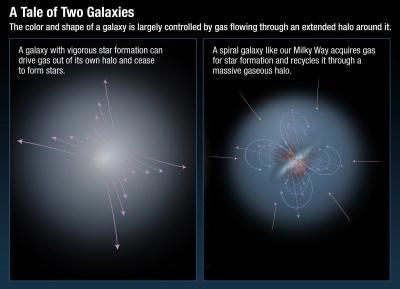Immense Gas Clouds a Part of Galaxies' Recycling Process

NASA's Hubble Space Telescope has given astronomers a better understanding of how galaxies continuously recycle immense volumes of hydrogen gas and heavy elements, which allows galaxies to build successive generations of stars stretching over billions of years.
The ongoing recycling keeps some galaxies from emptying their "fuel tanks" and stretches their star-forming epoch to over 10 billion years, according to NASA’s Goddard Space Flight Center.
Hubble Space Telescope observations and data from large ground-based telescopes in Hawaii, Arizona and Chile measured the properties of the galaxies. The authors explained that the conclusion is based on a series of Hubble Space Telescope observations that “flexed the special capabilities of its Cosmic Origins Spectrograph (COS) to detect gas in the halo of our Milky Way and more than 40 other galaxies.”
Hubble spectroscopic observations show that galaxies like our Milky Way recycle gas and astronomers believe that the color and shape of a galaxy is “largely controlled by gas flowing through an extended halo around it.”
Nicolas Lehner of the University of Notre Dame in South Bend, Ind., Jason Tumlinson of the Space Telescope Science Institute in Baltimore, Md., and Todd Tripp of the University of Massachusetts at Amherst led the study published in Science magazine.
The COS observations of distant stars showed halos of hot gas surrounding vigorous star-forming galaxies and demonstrate that a large mass of clouds is falling through the giant halo of our Milky Way, the authors wrote, fueling its ongoing star formation.
The hot hydrogen clouds 20,000 light years from the Milky Way disk contain enough material to make 100 million suns.
The authors explained that some of the gas is recycled material that is replenished continuously by star formation and the “explosive energy of novae and supernovae, which kicks chemically enriched gas back into the halo.”
The halos of star gas that surround vigorous star forming galaxies are rich in heavy elements and extend up to 450,000 light-years beyond the visible portions of their galactic disks.
Researchers found that this gas is “nearly absent from galaxies that have stopped forming stars,” and that the “recycling” process bursts a rapid firestorm of star birth that can blow away the remaining fuel, which can essentially turn off the activity of future star birth.
Gas pushed out of a galaxy, rather than pulled in from intergalactic space, determine a galaxy's fate, researchers said.
The Hubble observations showed that these rapid star forming galaxies can drive two-million-degree gas very far out into intergalactic space at speeds of up to two million miles per hour, which is fast enough for the gas to escape forever and never refuel the parent galaxy.
The authors explained that “while hot gas ‘winds’ from galaxies have been known for some time, the new COS observations reveal that hot outflows extend to much greater distances than previously thought and can carry a tremendous amount of mass out of a galaxy. Some of the hot gas is moving more slowly and could eventually be recycled.”
The observations showed that gas-rich star-forming spiral galaxies can evolve to elliptical galaxies and no longer have star formation.
The researchers used COS to detect the presence of the gas by the way it absorbs certain colors of light from background quasars, as the light emitted by the hot plasma is invisible.
“Quasars are the brightest objects in the universe and are the brilliant cores of active galaxies that contain active central black holes,” the authors wrote.
“The quasars serve as distant lighthouse beacons that shine through the gas-rich "fog" of hot plasma encircling galaxies.”
COS is highly sensitive to the presence of heavy elements, such as nitrogen, oxygen, and neon at ultraviolet wavelengths, which allows the study of many galaxies that lie in front of the much more distant quasars.
Published by Medicaldaily.com



























